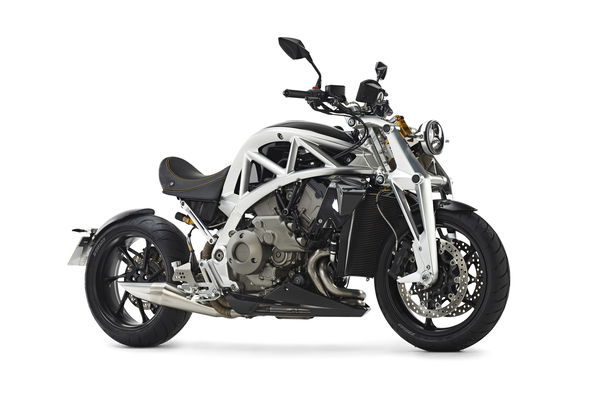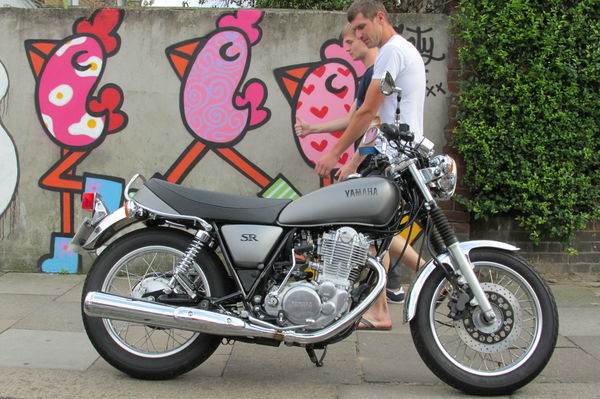First ride: Ariel Ace review
Who knew a VFR1200 engine could sound this good?


SOME people accuse Honda's VFR1200F of lacking character, of being too clinical, too much like a Honda.
Perhaps they should try the new Ariel Ace, using the same engine. It's an animal.
All Ariel have done to the 1,237cc V-four is put a louder exhaust on it, swap the airbox for filters and remap it to suit the modifications. Nevertheless it seems transformed, if only because of the noise that has been unleashed.
It's become an angry brute that answers with a deep, window-rattling induction growl the moment you twist your wrist. Crack it open and birds fly from trees 20 miles away. Ariel say it passes noise limits and is exactly what the production version will be like. I think they have found a deaf examiner. It's certainly a world away from the conservative VFR, and gives the engine a whole new personality.
The VFR seems so respectable, you could almost forget it's packing that 173hp colossus, and that it's disgustingly fast. Put the same plant in a trellis aluminium frame with bodywork and fairing stripped away and you have a machine for reeling in the horizon. A machine that demands space to be opened up.
According to Ariel's specifications the V-four makes slightly more torque in the Ace than in the VFR, at 96.6lbft compared to 95.1. Peak power is unchanged.
It pulls from as little as 2,000rpm. At about 5,000rpm it finds renewed energy and surges towards those peak figures and the red line at 11,000.
In fact the one I rode never got to any red line because the rev counter didn't work. That's because it's a prototype which Ariel generously agreed to let me test before the model goes into production next year.
As well as the engine, it gets the transmission and shaft drive from the VFR1200F. That means it's available with the VFR's optional Dual Clutch Transmission system, which combines automatic and semi-automatic modes with a six-speed box.
It also gets the VFR's combined-ABS brakes and traction control system.
So it's all the bits that make a VFR1200 stop and go, transplanted into that aluminium frame, which happens to look much better up close than in pictures, with a machined, rippled finish. The trellis design is intentionally reminiscent of the Ariel Atom car's chassis.
The rest of the bike is a matter of individual preference. The riding position, tank range, even the wheelbase and steering rake angle, can be chosen by customers. There's a choice of seats, with three different heights, and three tanks of varying capacities.
It's the same low-volume, bespoke production philosophy Ariel takes with its car, according to the firm.
The basic starting price of the Ace is £20,000, and for that you get a Showa shock and telescopic forks.
So far the firm has unveiled two prototype examples, one like a super naked, with telescopic forks, and one a bit like a cruiser, with an unconventional girder front suspension arrangement. That's the one I rode.
The girder is an intentional nod to heritage – Ariel motorcycles have historically used girder forks and now the first new bike from the British marque in over 50 years does too.
Ariel say the arrangement replicates the feel of telescopic forks because it compresses under braking. That's true – it does compress, and the linkage at the top moves up and down, giving a novel view of the suspension at work - but you don't feel as directly connected to the front wheel as you do through a conventional fork.
Telescopic forks compress along a straight line between the front wheel and handlebar. Because of the linkage, the girder compresses along a slightly different line, so that direct connection between hand and wheel is lacking. It feels more remote.
Neither does it respond quite as readily to input as you might expect telescopic forks to. If a corner tightens up, for example, a little more effort than usual is required to increase lean angle.
Mass may be a factor. The VFR's engine and transmission are hefty and have bestowed upon the Ace a kerb weight of 230kg. It's 37kg lighter than the VFR itself but nevertheless heavier than the Ace's stripped-down appearance might suggest. Moving it around at walking pace, it's clear it's no lightweight.
What can be said for the front end is that it's very stable. Once you overcome any initial distrust it becomes confidence-inspiring, as long as you pick the right cornering speed to begin with.
The girder uses an Öhlins shock, which is on show just in front of the headstock and can be adjusted while sitting on the bike. If you're the kind of person who's ready to spend £20,000+ on a motorcycle from a historic British marque, you probably want it to be something special, and an unusual front end with an Öhlins shock taking centre stage is one way of making sure it is. Another is to have the back tyre sticking out behind the rider's seat, with the number plate, rear light and hugger mounted to the drive-shaft.
The rear suspension felt hard for the road but, like the front, is fully adjustable. The seat was well shaped and supportive, curving up behind the rider, but also very hard. Ariel say they're still experimenting with this.
The riding position – of the version I rode at least – is like a Ducati Diavel's. The pegs are adjustable rearsets positioned directly below your body rather than out in front, as on a traditional cruiser. Your back is straight and your arms too, with a bit of a reach to the straight bars.
Try to grip the tank with your knees and instead you'll find the pointy edges of those trellis frame beams.
The cornering ground clearance is Diavel-like too: nowhere near as limiting as a traditional cruiser's but not exactly in sports bike territory either. It can be flattering to unexpectedly feel your toe touch the ground, though.
The Ace is not a sports bike, and that's okay because Ariel never said it would be. It may be a disappointment to some that it's not, given the nature of Ariel's cars, which might be the closest thing there is to sports bikes with four wheels. But where do you go if you're a maker of cars like sports bikes who is branching out into actual motorcycles for the first time in decades? There are already people who make sports bikes like sports bikes. Some of them are quite good at it.
Better for Ariel to make something a little different. Something not directly competing with the rest of the class because it stands apart from it. Something with an incredible, probably underrated engine, of proven reliability (because it's from one of those firms that's already quite good at making high-performance motorcycles).
Something to draw a crowd. Something special.
That's what Ariel seems to have made, and credit to them.
Watch our video review of the Ariel Ace.
Model tested: Ariel Ace
Price: From £20,000
Power: 173hp @ 10,000rpm
Torque: 96.6lbft @ 8,750rpm (up from 95.1lbft @ 8,750rpm)
Kerb weight: 230kg
Tank capacity: 14.1, 18.6 or 21.3 litres
Seat height: 745, 784 or 825mm
Colours: Name it
Availability: Orders being taken now for production run beginning spring 2015.
Read our Ducati Diavel first-ride review

























